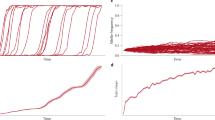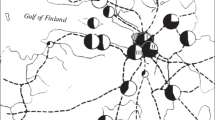Abstract
Standard population genetic theory suggests that adaptation should normally be achieved by the spread of many genes each of small effect (polygenes), and that adaptation by major genes should be unusual. Such models depend on consideration of the rates of acquisition of adaptation. In practice, adaptation to pollutants and anthropogenic toxins has most frequently been achieved by the spread of major genes. A simple model is developed to explain this discrepancy, in which the determining factor is not the rate of spread, but the maximum response achievable under the two contrasting models of polygenic or major gene inheritance. In the short term, for a given mean and genetic variance, characters in which the additive genetic variance is produced by the segregation of many genes of small effect at intermediate gene frequencies are unable to produce as large a response to directional selection as characters in which the variance is caused by genes of large effect at low frequency. If the ‘target’ for selection is a long way from the mean prior to selection (as it may well be for adaptation to novel anthropogenic stresses) then adaptation can only be achieved by species possessing major genes. The model is discussed with reference to the example of heavy metal tolerance in plants.
Similar content being viewed by others
References
Al-Hiyaly, S. A., McNeilly, T. & Bradshaw, A. D., 1988. The effects of zinc contamination from electricity pylons-evolution in a replicated situation. New Phytol. 110: 571–580.
Antonovics, J., 1968. Evolution in closely adjacent plant populations. V. Evolution of self fertility. Heredity 23: 219–238.
Antonovics, J., 1976. The nature of limits to natural selection. Ann. Missouri Bot. Gard. 63: 224–247.
Antonovics, J., Bradshaw, A. D. & Turner, R. J., 1971. Heavy metal tolerance in plants. Adv. Ecol. Res. 7: 1–85.
Baker, A. J. M., 1987. Metal tolerance. New Phytol. 106 (suppl.): 93–111.
Barton, N. H. & Turelli, M., 1989. Evolutionary quantitative genetics: how little do we know? Ann. Rev. Genet. 23: 337–370.
Bradshaw, A. D., 1984. The importance of evolutionary ideas in ecology-and vice versa. Pp 1–26. In: Shorrocks, B. (Ed) Evolutionary Ecology. Blackwell, Oxford.
Coyne, J. A. & Lande, R., 1985. The genetic basis of species differences in plants. Am. Nat. 126: 141–145.
Crow, J. F., 1957. Genetics of insect resistance to chemicals. Ann. Rev. Ent. 2: 227–246.
Gartside, D. W. & McNeilly, T., 1974. The potential for evolution of heavy metal tolerance in plants. II. Copper tolerance in normal populations of different plant species. Heredity 32: 335–348.
Greaves, J. H., Rennison, B. D. & Redfern, R., 1976. Resistance of the ship rat, Rattus rattus L., to warfarin. J. stored Prod. Res. 12: 65–70.
Jacobs, B. F., Duesing, J. H., Antonovics, J. & Patterson, D. T., 1987. Growth performance of triazine-resistant and-susceptible biotypes of Solanum nigrum over a range of temperatures. Can. J. Bot. 66: 847–850.
Kettlewell, H. B. D., 1973. The evolution of melanism. Clarendon Press, Oxford.
Lande, R., 1975. The maintenance of genetic variability by mutation in a polygenic character with linked loci. Genet. Res., Camb. 26: 221–235.
Lande, R., 1981. The minimum number of genes contributing to quantitative variation between and within populations. Genetics 99: 541–553.
Lande, R., 1983. The response to selection on major and minor mutations affecting a metrical trait. Heredity 50: 47–65.
Lees, D. R., 1981. Industrial Melanism: Genetic adaptation of animals to air pollution. Pp 129–176. In: Bishop, J. A. & Cook, L. M. (Eds) The Genetic Consequences of Man Made Change. Academic Press, London.
Macnair, M. R., 1981. Tolerance of Higher plants to toxic materials. Pp 177–207. In: Bishop, J. A. & Cook, L. M., (Eds) The Genetic Consequences of Man Made Change. Academic Press, London.
Macnair, M. R., 1983. The genetic control of copper tolerance in the yellow monkey flower, Mimulus guttatus. Heredity 50: 283–293.
Macnair, M. R., 1987. Heavy metal tolerance in plants: a model evolutionary system. TREE 2: 354–359.
Macnair, M. R., 1989. The genetics of metal tolerance in natural populations. Pp 235–254. In: J. Shaw, (Ed) Heavy metal tolerance in plants: Evolutionary aspects. CRC press, Boca Raton.
Macnair, M. R. & Cumbes, Q. J., 1989. The genetic architecture of interspecific variation in Mimulus. Genetics 122: 211–222.
Mallet, J., 1989. The evolution of insecticides resistance: have the insects won? TREE 4: 336–340.
Mather, K., 1973. Genetical structure of populations. Chapman and Hall, London.
Maynard Smith, J., 1989. Evolutionary Genetics. Oxford University Press, Oxford.
Orr, H. A. & Coyne, J. A., 1991. The genetics of adaptation: a reassessment. (in press).
O'Reilly, R. A., Aggeler, P. M., Hoag, M. S., Leong, L. S. & Kropotkin, B. A., 1964. Hereditary transmissions of exceptional resistance to coumarin anti-coagulant drugs. New Engl. J. Med. 271: 809–815.
Parsons, P. A., 1987. Evolutionary rates under Environmental Stress. Evol. Biol. 21: 311–347.
Schat, H. & ten Bookum, W. M., 1991. Genetic control of copper tolerance in Silene vulgaris Heredity (in press).
Sheppard, P. M., Turner, J. R. G., Brown, K. S., Benson, W. W. & Singer, M. C., 1985. Genetics and the evolution of Muellerian mimicry in Heliconius butterflies. Phil. Trans. Roy Soc. Lond., B. 308: 433–610.
Snape, J. W., Angus, W. J., Parker, B. & Leckie, D., 1987. The chromosomal locations in wheat of genes conferring differential response to the wild oat herbicide, difenzoquat. J. agric. sci., Camb. 108: 543–548.
Turelli, M., 1984. Heritable genetic variation via mutation-selection balance: Lerch's zeta meets the abdominal bristle. Theor. Pop. Biol. 25: 138–193.
Turner, J. R. G., 1978. Butterfly mimicry: the genetical evolution of an adaptation. Evol. Biol. 10: 163–206.
Wallace, M. E. & MacSwiney, F. J., 1976. A major gene controlling warfarin resistance in the house mouse. J. Hyg. Camb. 76: 173–181.
Wood, R. J., 1981. Insecticide resistance: genes and mechanisms. Pp 53–96. In: Bishop, J. A. & Cook, L. M. (Eds). The Genetic Consequences of Man Made Change. Academic Press. London.
Wu, L., Bradshaw, A. D. & Thurman, D. A., 1975. The potential for evolution of heavy metal tolerance in plants. III. The rapid evolution of copper tolerance in Agrostis stolonifera. Heredity 34: 165–187.
Author information
Authors and Affiliations
Rights and permissions
About this article
Cite this article
Macnair, M.R. Why the evolution of resistance to anthropogenic toxins normally involves major gene changes: the limits to natural selection. Genetica 84, 213–219 (1991). https://doi.org/10.1007/BF00127250
Received:
Accepted:
Issue Date:
DOI: https://doi.org/10.1007/BF00127250




